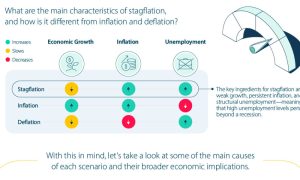Stagflation Begins
Nine of the 12 Federal Reserve districts reported a decline in economic activity in August, up five districts from the July Beige Book report. Our system has warned that we are entering a period of stagflation, where inflation remains high but GDP declines. Now, the Fed is reporting that two-thirds of the US economy is experiencing “flat or declining activity.”
The US economy advanced 3% during the last quarter, leading many to believe that the economy is recovering since Q2 posted a measly 1.4% advancement. Consumer spending, amounting to 70% of GDP, rose 2.9% last quarter as well, but people are spending on essentials. They fail to calculate TAXES into the equation when producing these reports and then dismiss essentials such as food and shelter as “volatile” aspects that somehow are not factored in the core figures.
Some people have a very hard time understanding that we are in a massive deflationary spiral; they think that rising prices simply means it is inflation and not deflation. Then, they mistake stagflation for deflation and wonder why people are spending more on less. They only see prices, not disposable income, and certainly not economic growth and unemployment.
The latest jobs report revealed that manufacturing is continuing to decline – shedding 24,000 jobs in July alone. On the other hand, the public sector grew by an additional 24,000, but those are 24,000 positions that will not contribute to GDP. Instead, growing government is simply growing the national debt but that figure no longer matters since it has long been unsustainable.
If you really look at it, objectively, interest rates always rise during boom periods, and they decline during recessions and depressions. We are looking at increased inflation into 2028 caused by shortages and war. But you’re looking at declining economic growth, so that ends up being more like the 1970s. The inflation rate will be higher than economic growth and we often see stagflation during times of war. We are beginning to see this come into play on the district level, but soon, it will be undeniable that the US has entered a period of contraction.


